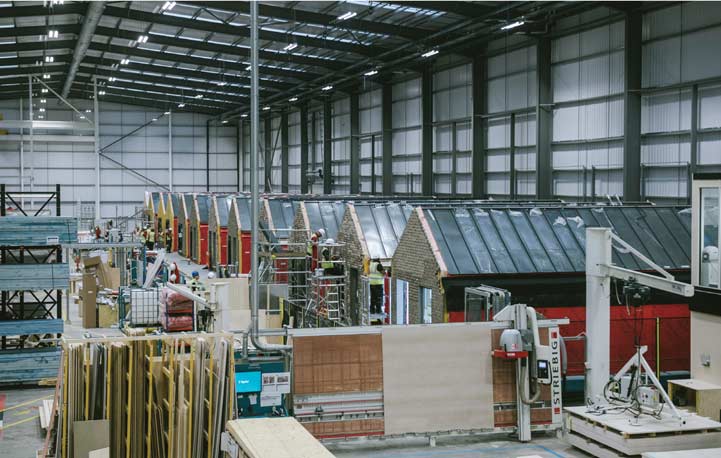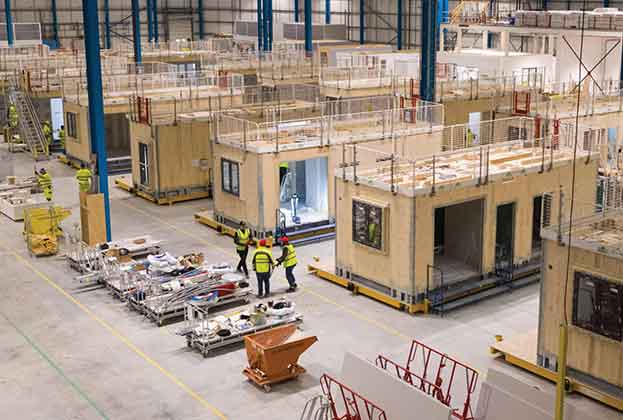The North and Midlands are emerging as centres of excellence for Modern Methods of Construction
The previous housing minister, Esther McVey, was a vocal advocate of MMC and trumpeted the creation of a ‘Construction Corridor’ across northern England. This aimed to create a centre of excellence for MMC.

Photo TopHat
Construction Corridor
The Government’s support for MMC manufacturing in the North serves not only the ‘levelling up agenda’ but also reflects where there is an emerging cluster of factories.
Our research has identified around 80 factories that are actively supplying the residential sector. These include those building volumetric modules, timber and steel frames, panels and assemblies.
We have identified 80 Modern Methods of Construction factories across the UK that are delivering 17,000 new homes
Savills Research
While there is a broad distribution across the country, there is a clear cluster running across the North West and Yorkshire and the Humber. This area is home to a third of all factories in the UK. These include three of the largest manufacturers, Etopia in Cheshire, Legal & General Modular just east of Leeds and ilke Homes in Knaresborough.
There is a second large cluster in the Midlands, with almost a quarter of factories. These are often found close to the motorway network, allowing easy transportation across the country. The main manufacturers include TopHat, Urban Splash and Sekisui House and Elements Europe.
The Welsh government is actively encouraging the sector, specifically to support the delivery of new social housing. This includes financial support for manufacturers, as well as a push for a ‘Welsh First’ approach to procurement. This has resulted in a number of factories locating and building supply chains within the country, which is now home to 16% of UK factories.
Where are MMC schemes?
One of the benefits of MMC is that the factory doesn’t have to be located near the site, which means high demand areas in London and the South East can draw upon the manufacturing capacity elsewhere.
We have identified over 100 schemes in the development pipeline utilising MMC. Combined these total around 17,000 new homes across a mixture of open market sale, Build to Rent (BTR), co-living and affordable tenures.
In terms of geographic spread, the majority of the new homes are due to be delivered in London and the South East, which mirrors where demand for new housing is highest. This includes Greystar and Tide Construction’s Ten Degrees, 100A George Street in Croydon, which is the world’s tallest modular tower and will deliver 546 BTR homes when completed. MMC’s faster construction make it a good match to BTR development as buildings become income producing earlier.
There are also concentrations of MMC delivery coming forward in the North West and Yorkshire & the Humber, including Urban Splash’s schemes at Wirral Waters, Birkenhead, and New Islington, Manchester, as well as a number of schemes by ilke Homes.
What is being delivered?
Of the roughly 10,000 new homes we have identified, almost half are being brought forward on open market sale schemes. These include Urban Splash and Sekisui House at Northstowe, where they will be delivering 406 new homes, of which 325 are for open market sale.
But what is interesting is the level of delivery on wholly affordable housing schemes. While these only account for around a fifth of total units, they account for almost half of all schemes. This reflects a more cautious approach being taken by many housing associations and local authorities who are running small pilot programs. This is borne out looking at the average size of an affordable only scheme, which is only 45 units compared with 131 for an open market sale scheme.
Where next for demand?
In the short term, demand for MMC is likely to be driven by the need to increase housing delivery and shortage of construction workers. While we expect demand to arise across the country, these two drivers indicate it is likely to be strongest in London, South East and East of England.
These are the regions showing the largest supply and demand gap and related affordability challenges. Furthermore, London’s construction industry is heavily reliant upon foreign labour, particularly those from the EU, whose access is likely to be impacted by the proposed new immigration rules post Brexit.
The big question though, is how much will the disruption caused by Covid-19 drive wider adoption across the country and super charge demand nationally?
Read the articles within Spotlight: Modern Methods of Construction below.
.jpg)
